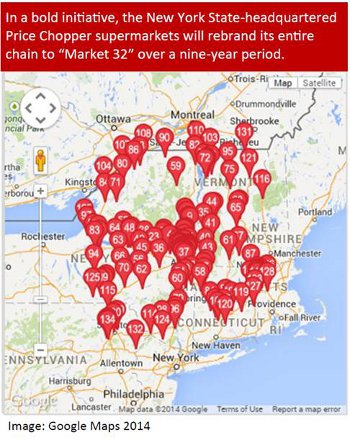Betting big on fresh: the Price Chopper gamble
 In November, we came across one of the most startling announcements in years from the conventional grocery retail world. And yet few seem to understand what is at stake for the rest of the country. On November 11, a predominantly small-town American grocery chain from New York State, Price Chopper, announced that it would take its fresh-oriented incubator test format from an affluent Albany suburb and use key principles from it to rebrand its entire system (135 stores) as “Market32.” We have never seen a system renovation this ambitious and this extensive by an independent operator. Price Chopper has gone all in on all things fresh. And it will be either the biggest mistake of grocery retail in the last decade or a defining tipping point for a flatlining midmarket grocery sector.
In November, we came across one of the most startling announcements in years from the conventional grocery retail world. And yet few seem to understand what is at stake for the rest of the country. On November 11, a predominantly small-town American grocery chain from New York State, Price Chopper, announced that it would take its fresh-oriented incubator test format from an affluent Albany suburb and use key principles from it to rebrand its entire system (135 stores) as “Market32.” We have never seen a system renovation this ambitious and this extensive by an independent operator. Price Chopper has gone all in on all things fresh. And it will be either the biggest mistake of grocery retail in the last decade or a defining tipping point for a flatlining midmarket grocery sector.
The move by Price Chopper is compelling since most every supermarket operator that has reinvented their stores toward all things fresh has engaged in highly compartmentalized experiments that utilize new stores, not renovations. Examples include:
- HEB, which invented Central Market long ago when super-fresh oriented stores were relatively new
- Roundy’s, which unleashed its Mariano’s stores on a rapid timeline to accomplish a similar goal
Other grocers have simply created small test stores like Kroger’s Marketplace and Giant Eagle’s Market District; but these experiments have not really bet big on transforming entire systems toward a hyper-fresh model.
So, what is going on with Price Chopper? Are they making an enormous mistake to go this big this fast? Or are they simply taking a calculated risk (for $300 million) that may finally convince everyone else that this is the future of the American grocery store?
In 2013, we wrote a stark evaluation of the American midmarket grocery landscape that concluded that fresh foods were the one unique driver of your average grocery store in America. Fresh foods have been the categories that have held their own or grown share in the face of the relentless onslaught of Walmart, convenience operators, drug chains and hard discounters like ALDI, Bottom Dollar and Winco.
 Fresh food is also very well insulated from e-commerce sales … for now. When Americans want fresh perishables they have always headed to their local grocery store. But now, they also want to buy prepared foods, baked goods, fresh olives, marinated meats, etc. The world of fresh has become broader and skews highly upmarket in American food culture.
Fresh food is also very well insulated from e-commerce sales … for now. When Americans want fresh perishables they have always headed to their local grocery store. But now, they also want to buy prepared foods, baked goods, fresh olives, marinated meats, etc. The world of fresh has become broader and skews highly upmarket in American food culture.
While this may seem obvious in a world where Whole Foods Market, The Fresh Market, Wegmans and local specialty retailers have continued to grow market share, the reality is that most midmarket grocers’ profit models are still trapped in the center store. They just can’t seem to figure out how to convert square footage to expand the super-fresh perimeter where all the growth and action is, especially when all their suppliers continue to throw large amounts of profitable trade spending their way to promote packaged foods.
Much of this dilemma behind making the switch upmarket to all things fresh is a sheer battle of entrepreneurial nerves. But, increasingly, midmarket grocers have no choice. Chasing the discounters downmarket is financially nonviable for hi-lo midmarket grocers with high operating costs. They have tried for over a decade and continue to lose market share.
By going big on fresh, food-forward retailers are able to focus on making the perimeter of the store the epicenter of their business, much as Whole Foods Market continues to do. A tight focus on fresh, especially emerging categories like fresh dips, grab-n-go fresh meals, etc., enables retailers to upsell local shoppers with food experiences that discounters will never attempt to reproduce. Why? They don’t have the heritage of high-touch customer service nor the store employees to pull it off.
Price Chopper may just pull off the most radical reinvention in grocery history. Why? They are a privately held, employee-owned and family-managed company. This means that they have a frontline and backstage staff entirely vested in the success of this reinvention.
If we’ve learned one thing about converting to a fresh-oriented retail model, it’s that you absolutely have to have a committed, enthusiastic staff. Shoppers don’t trust retailers’ fresh offerings when they don’t appear to care about fresh food and when store employees provide little more than utilitarian services. There is something essentially intimate about selling fresh perishables and foods: It’s a theater in which consumers’ highest standards of quality are invoked. But the payoff is increasingly big. Price Chopper has most likely learned that you can make good money on the fresh perimeter. It does not have to be the low-margin trip driver that grocery veterans assume it to be.
We wish Price Chopper well in its big gamble. We think they represent the future of the neighborhood grocery store in America.
